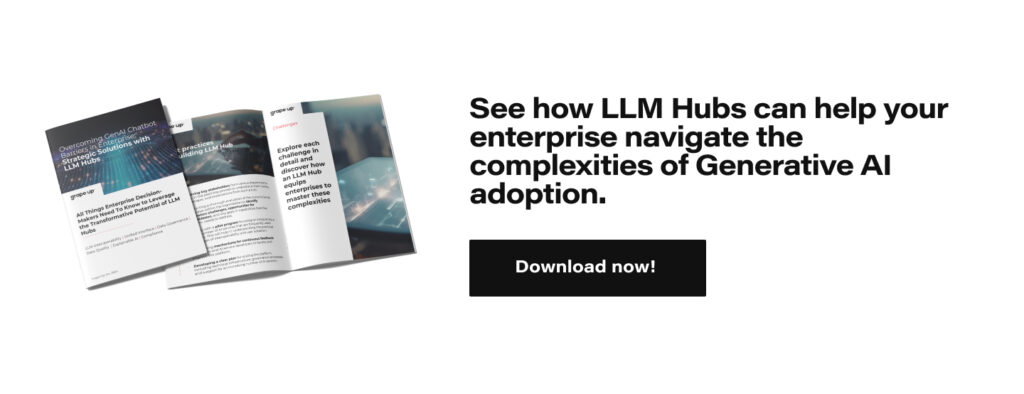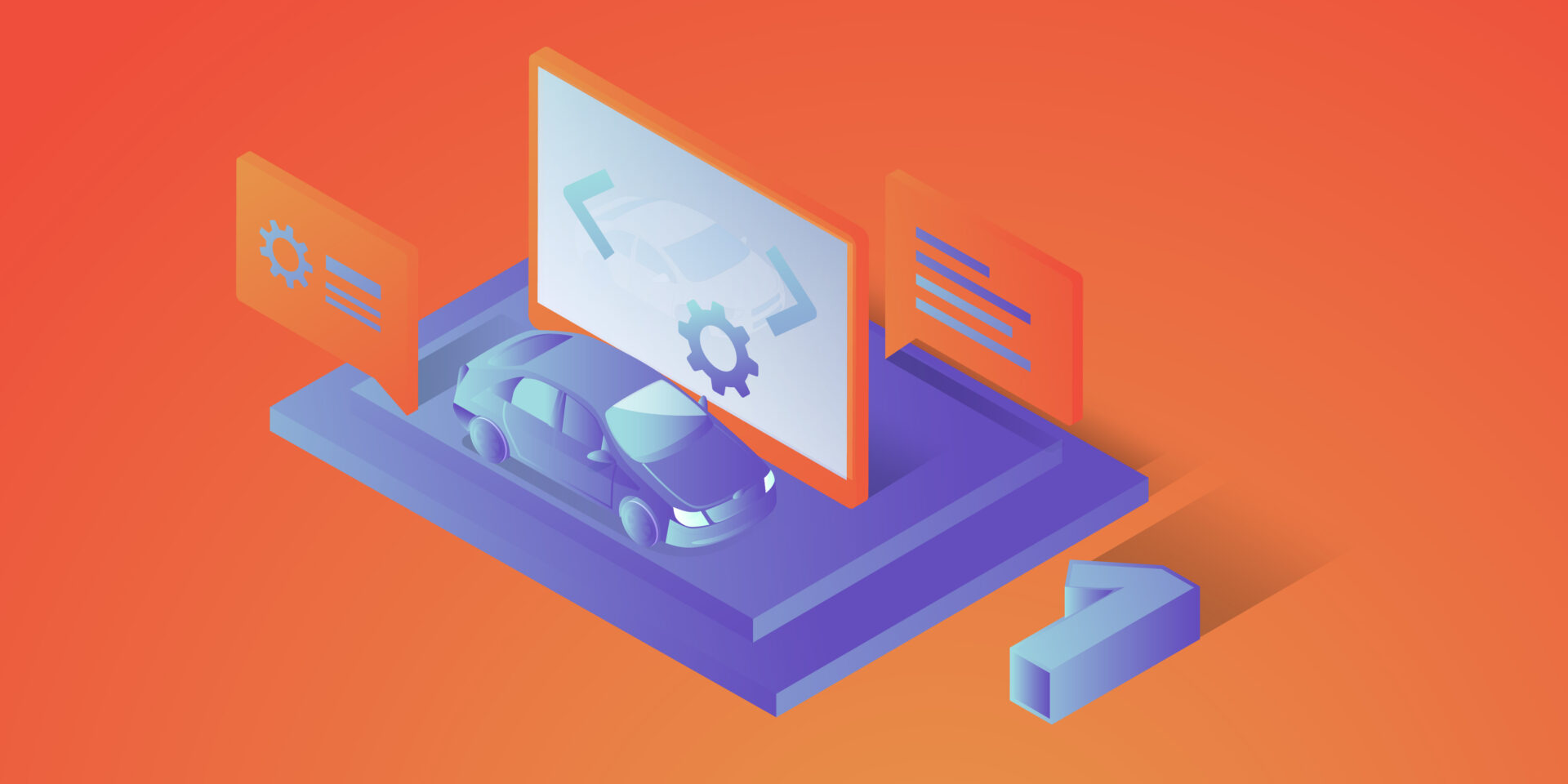Addressing Data Governance Challenges in Enterprises Through the Use of LLM Hubs

In an era where more than 80% of enterprises are expected to use Generative AI by 2026, up from less than 5% in 2023, the integration of AI chatbots is becoming increasingly common. This adoption is driven by the significant efficiency boosts these technologies offer, with over half of businesses now deploying conversational AI for customer interactions.
In fact, 92% of Fortune 500 companies are using OpenAI’s technology, with 94% of business executives believing that AI is a key to success in the future.
Challenges to GenAI implementation
The implementation of large language models (LLMs) and AI-driven chatbots is a challenging task in the current enterprise technology scene. Apart from the complexity of integrating these technologies, there is a crucial need to manage the vast amount of data they process securely and ethically. This emphasizes the importance of having robust data governance practices in place.
Organizations deploying generative AI chatbots may face security risks associated with both external breaches and internal data access. Since these chatbots are designed to streamline operations, they require access to sensitive information. Without proper control measures in place, there is a high possibility that confidential information may be inadvertently accessed by unauthorized personnel.
For example, chatbots or AI tools are used to automate financial processes or provide financial insights. Failures in secure data management in this context may lead to malicious breaches.
Similarly, a customer service bot may expose confidential customer data to departments that do not have a legitimate need for it. This highlights the need for strict access controls and proper data handling protocols to ensure the security of sensitive information.
Dealing with complexities of data governance and LLMs
To integrate LLMs into current data governance frameworks, organizations need to adjust their strategy. This lets them use LLMs effectively while still following important standards like data quality, security, and compliance.
- It is crucial to adhere to ethical and regulatory standards when using data within LLMs. Establish clear guidelines for data handling and privacy.
- Devise strategies for the effective management and anonymization of the vast data volumes required by LLMs.
- Regular updates to governance policies are necessary to keep pace with technological advancements, ensuring ongoing relevance and effectiveness.
- Implement strict oversight and access controls to prevent unauthorized exposure of sensitive information through, for example, chatbots.
Introducing the LLM hub: centralizing data governance
An LLM hub empowers companies to manage data governance effectively by centralizing control over how data is accessed, processed, and used by LLMs within the enterprise. Instead of implementing fragmented solutions, this hub serves as a unified platform for overseeing and integrating AI processes.
By directing all LLM interactions through this centralized platform, businesses can monitor how sensitive data is being handled. This guarantees that confidential information is only processed when required and in full compliance with privacy regulations.

Role-Based Access Control in the LLM hub
A key feature of the LLM Hub is its implementation of Role-Based Access Control (RBAC). This system enables precise delineation of access rights, ensuring that only authorized personnel can interact with specific data or AI functionalities. RBAC limits access to authorized users based on their roles in their organization. This method is commonly used in various IT systems and services, including those that provide access to LLMs through platforms or hubs designed for managing these models and their usage.
In a typical RBAC system for an LLM Hub, roles are defined based on the job functions within the organization and the access to resources that those roles require. Each role is assigned specific permissions to perform certain tasks, such as generating text, accessing billing information, managing API keys, or configuring model parameters. Users are then assigned roles that match their responsibilities and needs.
Here are some of the key features and benefits of implementing RBAC in an LLM Hub:
- By limiting access to resources based on roles, RBAC helps to minimize potential security risks. Users have access only to the information and functionality necessary for their roles, reducing the chance of accidental or malicious breaches.
- RBAC allows for easier management of user permissions. Instead of assigning permissions to each user individually, administrators can assign roles to users, streamlining the process and reducing administrative overhead.
- For organizations that are subject to regulations regarding data access and privacy, RBAC can help ensure compliance by strictly controlling who has access to sensitive information.
- Roles can be customized and adjusted as organizational needs change. New roles can be created, and permissions can be updated as necessary, allowing the access control system to evolve with the organization.
- RBAC systems often include auditing capabilities, making it easier to track who accessed what resources and when. This is crucial for investigating security incidents and for compliance purposes.
- RBAC can enforce the principle of separation of duties, which is a key security practice. This means that no single user should have enough permissions to perform a series of actions that could lead to a security breach. By dividing responsibilities among different roles, RBAC helps prevent conflicts of interest and reduces the risk of fraud or error.
Practical application: safeguarding HR Data
Let’s break down a practical scenario where an LLM Hub can make a significant difference – managing HR inquiries:
- Scenario: An organization employed chatbots to handle HR-related questions from employees. These bots need access to personal employee data but must do so in a way that prevents misuse or unauthorized exposure.
- Challenge: The main concern was the risk of sensitive HR data—such as personal employee details, salaries, and performance reviews—being accessed by unauthorized personnel through the AI chatbots. This posed a significant risk to privacy and compliance with data protection regulations.
- Solution with the LLM hub:
- Controlled access: Through RBAC, only HR personnel can query the chatbot for sensitive information, significantly reducing the risk of data exposure to unauthorized staff.
- Audit trails: The system maintained detailed audit trails of all data access and user interactions with the HR chatbots, facilitating real-time monitoring and swift action on any irregularities.
- Compliance with data privacy laws: To ensure compliance with data protection regulations, the LLM Hub now includes automated compliance checks. These help to adjust protocols as needed to meet legal standards.
- Outcome: The integration of the LLM Hub at the company led to a significant improvement in the security and privacy of HR records. By strictly controlling access and ensuring compliance, the company not only safeguarded employee information but also strengthened its stance on data ethics and regulatory adherence.
Conclusion
Robust data governance is crucial as businesses embrace LLMs and AI. The LLM Hub provides a forward-thinking solution for managing the complexities of these technologies. Centralizing data governance is key to ensuring that organizations can leverage AI to improve their operational efficiency without compromising on security, privacy, or ethical standards. This approach not only helps organizations avoid potential pitfalls but also enables sustainable innovation in the AI-driven enterprise landscape.
Looking for guidance on how to implement LLM Hubs for improved data governance? At Grape Up, we can provide you with expert assistance and support. Contact us today and let’s talk about your Generative AI strategy.
Check related articles
Read our blog and stay informed about the industry's latest trends and solutions.
see all articles






